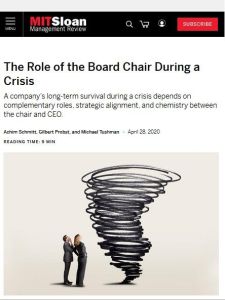Join getAbstract to access the summary!

Join getAbstract to access the summary!
Achim Schmitt, Gilbert Probst and Michael Tushman
The Role of the Board Chair During a Crisis
MIT Sloan Management Review, 2020
What's inside?
How can chairs help balance the company in turbulent times?
Recommendation
As the COVID-19 crisis places unprecedented pressures on chief executives, the role of board chairs becomes more necessary than ever. To help chairs understand how they can best lead during times of turmoil, MIT Sloan Management Review turns to a trio of distinguished authors – Achim Schmitt, Gilbert Probst and Michael Tushmanto – who offer a concise but crucial set of recommendations.
Summary
About the Authors
Achim Schmitt, a former turnaround and bankruptcy consultant, teaches strategic management at Ecole hôtelière de Lausanne, Switzerland. Gilbert Probst, former managing director at the World Economic Forum, is the board chair at the Swiss Bank of Geneva and honorary professor at the University of Geneva. Founder of change logic Michael Tushman is Baker Foundation Professor, Paul R. Lawrence Professor Emeritus, and faculty chair of the Advanced Management Program at Harvard Business School.



















Comment on this summary